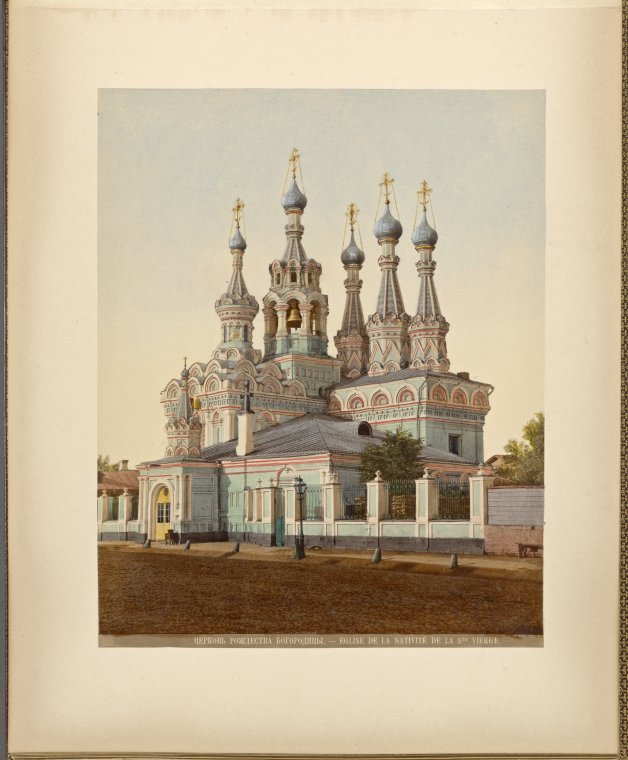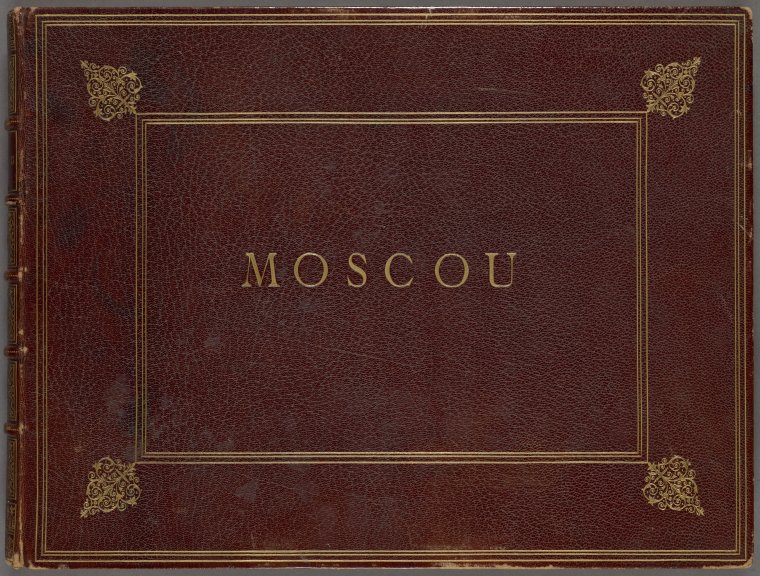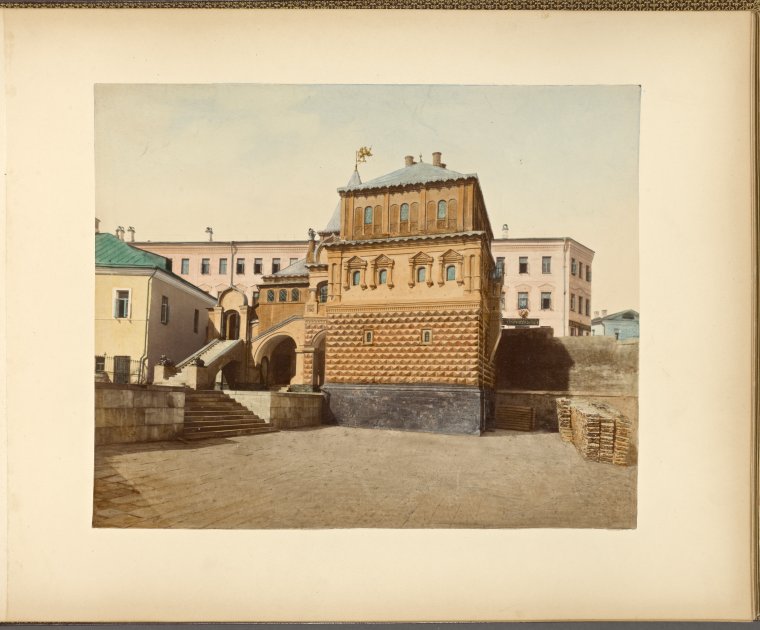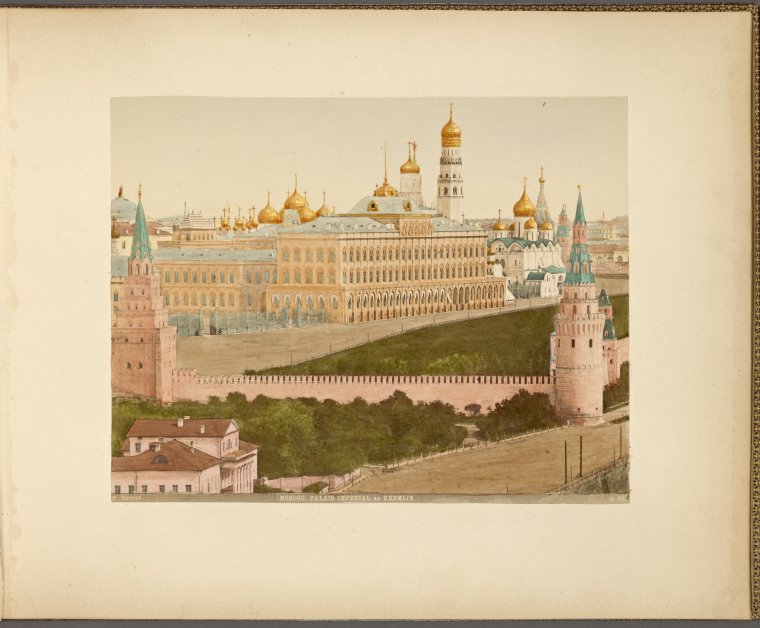The 19th Century Hand Colored Photographs of Moscow by J. Daziaro
The NYPL’s Slavic and East European photographic collection is very rich and unique. Many photographs have been digitized, including two albums with photographs of Moscow published by J. Daziaro, a company active in Russia for almost 90 years.
J. Daziaro in Russia owes its beginning to Giuseppe Daziaro (1796 or 1806-1865), who was a publisher and merchant of prints. While working as a commission agent, he traveled extensively throughout Russia and nearby countries. In 1827, he decided to set up his own store in Moscow, first on Lubianka Square and then, more significantly, at 7 Kuznetskii Most. This short two-block street was home to the high-end luxury trade since the early decades of the 19th century. In addition to J. Daziaro, the elegant street featured the German company Brothers A. and la. Allschwang, which sold dry goods and lingerie. The Italian luxury firm, Avanzo and Co., sold paints.
Giuseppe Daziaro, who was known in Russia as Iosif Khristoforovich Datsiaro, not only specialized in the sale of lithographed prints but also opened his own lithographic workshop in 1832. His firm is described as Russia’s first private publishing house of printed art graphics. Ultimately, it was more profitable to purchase printed materials elsewhere, so Daziaro closed the workshop after operating it for seven years. In 1838, Daziaro began working with his younger brother Giacomo and opened a shop in St. Petersburg at 1 Nevsky Prospekt. Stores in Paris (1850) and Warsaw (1855) expanded their business beyond Russia.
After Giuseppe Daziaro’s death, his brother closed their Paris location and returned to Italy. The Moscow store passed into the hands of his clerk I. L. Gel’dvein and Giuseppe's eldest son, Giuseppe (Joseph) Daziaro / Iosif Iosifovich Datsiaro (1831-1892). Under his management, the company also created and sold photographs, including those with views of cities in Russia, portraits of writers, actors, statesmen, and public figures, as well as photographs of famous paintings.
It was during this time that two albums with photographs of Moscow now held by the NYPL were issued. Souvenir de Moscou consists of 12 black and white photographs mounted on cards with Russian, French, and English captions on verso. This undated album retains the original publisher's blue cloth with gilt and black decorations and embossed lettering on the upper cover. The other album is simply called Moscou. It contains 27 hand-colored photographs mounted on cards. The title page is hand-lettered while the album is bound in burgundy morocco. Captions to some illustrations are in Russian and/or French.

J. Daziaro’s photographs were highly regarded. Gaspard-Félix Tournachon (1820-1910), better known as Nadar, a French photographer who in 1858 became the first person to take aerial photographs, wrote in his memoir that "there is no photographer of a certain age who has not held in his hands some photographs by Luckhardt, Alessandri, Daziaro—the classics—, and did not admire the perfect results, due to the precision of the execution."
After Giuseppe’s death, the firm was operated by his son Alexander. Big windows and huge display cases, where new items were exhibited daily, continued to attract the attention of passersby. The store carried a larger variety of merchandise. In addition to prints and photographs, it sold art reproductions, paintings, postcards of their own production, frames and art supplies.
J. Daziaro, like many other businesses in Moscow, closed in 1918. It lives on through its lithographs and photographs, and in the memories of those who shopped there. Leo Tolstoy (1828-1910) was one of them. In his 1855 memoire (p. 251) he wrote:
I drove to the Kuznetzky Bridge, with glances turned on me from all sides, with the bright sunlight on my buttons, on the cockade in my hat, and on my dagger, and drew up near Datziaro's picture shop. I glanced about me on all sides, and entered. I did not want to buy Victor Adam's horses, lest I should be accused of aping Volodya; but hurrying to make my choice as quickly as possible, out of shame at the trouble to which I was putting the polite shopman, I took a female head painted in water-colours which stood in the window, and paid twenty rubles for it. But after expending twenty rubles I felt rather conscience-stricken at having troubled the two handsomely-dressed shopmen with such trifles, and yet it seemed as though they looked at me in altogether too negligent a way. Desirous of letting them understand who I was, I turned my attention to a small silver piece which lay beneath the glass, and learning that it was a pencil-holder worth eighteen rubles, I ordered it done up in paper, paid my money, and learning also that good pipes and tobacco were to be had in the adjoining tobacco shop, I bowed politely to the two shopmen and stepped into the street with my picture under my arm.
For further reading:
- “Giuseppe Daziaro,” Frits Lugt, Les Marques de Collections de Dessins & d’Estampes | Fondation Custodia.
- Gusarov, Andrei. Istoricheskie zdaniia Peterburga : proshloe i sovremennost’ : adresa i obitateli (Moskva: TSentrpoligraf; Sankt-Peterburg: Russkaia troika-SPb, 2018).
- Kaganov, G. Z. and Miroliubova, G. A. Moskva i okrestnosti v litografiiakh firmy Dzhuzeppe Datsiaro: iz sobraniia Gosudarstvennogo muzeia A.S. Pushkina (Moskva: "Iskusstvo", 1996).
- Potkina, Irina V. “ Moscow’s Commercial Mosaic,” in: James L. West and Iurii A. Petrov, eds., Merchant Moscow: Images of Russia's Vanished Bourgeoisie (Princeton, N.J.: Princeton University Press, 1998): 37-44.
- Shealeva, E.P. Moskva v fotografiiakh: konets XIX—nachalo XX veka (Sankt-Peterburg: Liki Rossii, 2004).
- Shipova, T.N. Fotografy Moskvy (1839-1930): biograficheskiĭ slovarʹ-spravochnik (Moskva: Sovpadenie, 2006).
- ----------. Fotografy Moskvy na pamiat’ budushchemu, 1839-1930: alʹbom-spravochnik (Moskva: Izd-vo obʺedineniia "Mosgorarkhiv", 2001).
For the description and checklists of the NYPL’s Slavic and East European visual resources:
- Davis, Robert H. Jr. “Russian and Soviet Illustrated Books and Photographs at the New York Public Library,” Solanus n.s. 4 (1990): [87]-99.
- Goldsmith, Benjamin E. “Notable Russian and Soviet Illustrated Books and Photographs at the New York Public Library: A Selective List of Materials Preserved with Funds from the Department of Education's Title II-C Program,” Visual Resources IX (1993): 1-28.
- Kasinec, Edward, and Robert H. Davis, Jr. “The Russian Illustrated Book and Photographic Collections of the Slavic and Baltic Division, The New York Public Library: A Preservation Project Funded by the Department of Education,” Visual Resources VII (1990): 31-41.
- Smith-Peter, Susan and Hee-Gwone Yoo. “Pre-Revolutionary Russian Photography at the New York Public Library: An Introduction,” Slavic & East European Information Resources 19:3-4 (2018): 263-368.
- Yoo, Hee-Gwone and Kristen A. Regina. Visual Resources from Russia and Eastern Europe in the New York Public Library: A Checklist; preface by John E. Bowlt; introduction by Kristen A. Regina (New York: Ross Pub., 2008).
- Werneke, Jessica and Hee-Gwone Yoo. “Soviet Photography in America: An Introduction to the New York Public Library’s Revolutionary and Post-Revolutionary Slavic, East European, and Baltic Collection,” Slavic & East European Information Resources 19:3-4 (2018): 369-421.
Read E-Books with SimplyE
 With your library card, it's easier than ever to choose from more than 300,000 e-books on SimplyE, The New York Public Library's free e-reader app. Gain access to digital resources for all ages, including e-books, audiobooks, databases, and more.
With your library card, it's easier than ever to choose from more than 300,000 e-books on SimplyE, The New York Public Library's free e-reader app. Gain access to digital resources for all ages, including e-books, audiobooks, databases, and more.
If you don’t have an NYPL library card, New York State residents can apply for a digital card online or through SimplyE (available on the App Store or Google Play).
Need more help? Read our guide to using SimplyE.


